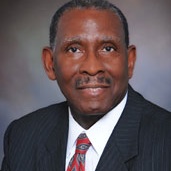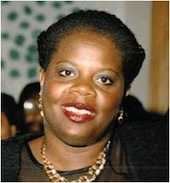History
1970's BLSA's Anchor
The history of BLSA at Northeastern University School of law can be traced back to the 1970's with distinguished Professor Denise S. Carty-Bennia. Professor Bennia was crowned the High Priestess/ Earth Mother by friends and colleagues. Professor Bennia was an active participant in movements opposing sex and race discrimination in the United States. She embodied the ideal of being BLSA strong. She was the sole African American professor, the first tenured African American, and the anchoring force for Black students at NUSL until 1985. Professor Bennia is considered one of the strongest advocates NUSL has ever had for increasing student diversity. Professor Bennia passed away on September 11, 1990, at the age of 43.
In a tribute in the Berkeley Women's Law Journal, Professor Bennia was described as someone who had an "enormous faith and compassion for black youth and directed so much of her energy to opening the doors for them." In a St. Louis University Law Review Memorial she was described as someone who represented
"one of those rare, passionately committed souls who was so uncompromising in her attitude that she could make a difference in the struggle to identify the ideal conditions for human existence. [...] She symbolized persons of color performing with excellence, courage, strength, dedication, love, and sensitivity in the very demanding and sometimes destructive arena of legal education."
In the past, BLSA has honored Professor Bennia's legacy in its work throughout the years via the Denise Carty-Bennia yearly event, and through five Bar scholarships of 1,000 dollars each, open to 3L's of color. BLSA carries Professor Bennia's spirit, vigor, brilliance and legacy always.
1985 Provost Hall
 Professor David Hall was the second African American Professor to find a home at NUSL. Professor David Hall entered the law school as an Associate Professor. He then became an Associate Dean, Dean, and finally the Provost of the institution. During former Provost Hall's tenure, he instituted several BLSA traditions including the 1L induction ceremony, and the 3L Event. Many of these events were hosted by Provost Hall and his wife Marilyn Braithwaite-Hall (herself a Northeastern Graduate, distinguished scholar, and Doctor of Philosophy) at their home.
Professor David Hall was the second African American Professor to find a home at NUSL. Professor David Hall entered the law school as an Associate Professor. He then became an Associate Dean, Dean, and finally the Provost of the institution. During former Provost Hall's tenure, he instituted several BLSA traditions including the 1L induction ceremony, and the 3L Event. Many of these events were hosted by Provost Hall and his wife Marilyn Braithwaite-Hall (herself a Northeastern Graduate, distinguished scholar, and Doctor of Philosophy) at their home.
These traditions still stand. 1L students are a part of a pinning ceremony, and welcomed into the BLSA family by faculty, staff, and upper level BLSA students. 3L students are honored as graduates and welcomed into the legal profession in a ceremony that includes attendance by faculty and staff, adornment with Kente cloth stoles, speeches from 1L and 2L students, a bountiful dinner, and a traditional ancestral honoring ceremony by BLSA’s faculty advisor.
1986 CAIR
Throughout its tenure, BLSA has been heavily involved in the Committee Against Institutional Racism (CAIR). CAIR coalesced as an ad hoc group in Spring 1986 because of an intense feeling among students of color of the need for such a body. The Committee was initially led by Asian American students who also felt the sting of race issues within the institution.
CAIR was officially recognized on April 17, 1986, when the governing charter, then known as the "Advisory Council Document of August 17, 1972" was amended to establish CAIR as a standing institutional committee for the purpose of "develop[ing] programs and strategies to eradicate institutional racism and to enhance the overall quality of life for all people of color in the law school community."
In the early days CAIR provided a forum for students of color to voice concerns, become informed about law school governance, and to keep the wider community alert to controversies and problem-areas needing attention. CAIR also created regular and more relaxed channels of communication between students of color, administration and faculty. A tradition was observed for many years in which the law School sponsored a quarterly luncheon for students of color and members of the faculty and administration to get to know each other in a safe, non-classroom environment and to discuss issues of substance both formally and informally.
CAIR met on a regular basis, tried to convene meetings between faculty and students of color, put on skits, etc. to raise awareness around issues of racism. CAIR sent a powerful message that the institution was willing to address race.
CAIR is synonymous with the following activities, some of which still persist today:
- Membership on the Law School Governing Charter and membership on the Standing Committee. This allows student CAIR representatives to sit on committees such as the Appointments Committee, Academics, Student Life, Curriculum, etc.
- Events and luncheons with faculty and senior administrators. These events are a great opportunity for students of color to get to know staff and faculty.
- CAIR facilitated a "consciousness-raising process" among faculty and senior administrators. At least annually, and often as frequently as quarterly, CAIR conducted an event aimed (a) to make faculty aware of the unique problems students of color face in legal education, and (b) to create awareness about unintended faculty and administrator behaviors that cause hurt or obstacles to progress for students of color. CAIR also urged the faculty to undertake formal diversity-training programs.
- CAIR was a de facto "grievance committee" or "emergency-response forum." CAIR provided a sounding board for the students of color and attempted to facilitate dialogue with the faculty or other community members involved in issues that students experienced as offensive by students of color.
- On an ad hoc basis, CAIR sponsored community-wide educational programs on racism and diversity issues, such as guest lectures, films, and forums.
1991 BLSA Renamed
In the early period of Egypt, during the Old Kingdom, Egypt was referred to as Kemet (Kermit), or simply Kmt, which means the Black Land or Black People. The people called themselves "remetch en Kermet," which means the "People of the Black Land." The term refers to the rich soil found in the Nile Valley and Delta (see http://www.fitzmuseum.cam.ac.uk/dept/ant/egypt/kemet/virtualkemet/faq/). The name Kemet was adopted by the Northeastern University Black Law Students Association in 1991. Students wanted the chapter to reflect the deeper richness of Egypt and other continental African roots.
Kemet is one of the only BLSA chapters in the country with a name of this kind. The name reflects the political engagement of the students in the early 90's. The purpose of the Kemet chapter, as written in the bylaws, is to support and encourage specifically students of African descent. The name Kemet reflected Afrocentrism and embraced the solidarity and social activism of the chapter.
1991 The Walkout
The legal climate of the early 90's was plagued with issues of retention of students and faculty of color. This was not unique to Northeastern, but the Kemet chapter stepped up in a unique way to demand change. Students felt as though issues of race were not being addressed in their first year courses. A group of students in Professor Mike Meltsner's Criminal Law class felt as though he was not receptive to their concerns around race. During the second semester of the 1L's first year, these students chose to take strategic action, orchestrating a walk out.
Student members of BLSA, LALSA, APALSA and some progressive white students coming from the first-year class of 1993, participated and supported the walkout. Many of the white students were members of the National Lawyers Guild and various LGBTQ+ organizations in the law school. There were members of the Coalition who had previously participated in direct action campaigns in the Free South Africa Movement and other progressive causes and were able to plan the action down to the minute details. Students stood up in Meltsner's class, while Meltsner was speaking. They began chanting "No more Silence" and filed out of his classroom. Students proceeded to march through the halls of NUSL. The next day, Coalition leaders Christian Lamar, Valerie Gordon, and Alan Sun met and discussed with then Dean Givelber, Academic Dean Hall, and Asst. Dean Spieler a list of demands.
Amongst the issues raised were: the need for more students of color, the need for more TA's of color, and the need for more faculty of color. Additionally, students proposed the idea of creating a mandatory separate course for first year students that would specifically deal with issues of diversity.
A little over a year after the Walkout, those demands had been met. The fruits of student labor were (a) the hiring of three faculty members of color in 1991 and (b) the creation of the Law, Culture, and Difference course which later became Legal Skills in Social Context. Dean James Hackney was among the three professors of color hired. At the time Professor Margarett Woo stood as the first and only Asian American faculty member, and Professor Debbie Ramirez stood as the only Latino faculty member.
 1993 VG Lecture
1993 VG Lecture
The Valerie Gordon Lecture was spawned from the hiring of Professor Hope Lewis who approached then Dean Hall about starting a human rights program at NUSL. Prof. Lewis believed that African American people should be concerned with human rights on both the domestic and international level. In 1993 Prof. Lewis and Dean Hall began an annual lecture series dedicated to Valerie Gordon who was a former NUSL student, and an inspiring and active civil and human rights advocate. Professor Hope Lewis was the faculty coordinator of the lecture for 13 years and then the founding Faculty Director of the Program on human Rights and Global Economy (PHRGE).
When Valerie Gordon passed away, Kemet Chapter created a Spirit of Valerie Gordon Book Award (as supported by Dean Hall) to honor a BLSA student who wrote the most compelling essay on a theme selected by the BLSA executive board.
The Evolution of Legal Skills in a Social Context
Law, Culture, and Difference, later Legal Skills in a Social Context, welcomed a processional of renowned voices to speak at NUSL about various issues. One of the first speakers was Historian, Scholar, and Philosopher, Molefi Kete Asante. Law, Culture, and Difference soon evolved into a full 1 credit hour course.
From 1991 to 1997, the course went through a number of changes. In 1997, Distinguished Professor, and former Judge Susan Maze Rothstein was asked to head the program. Professor Rothstein, with extensive input from faculty, students and fellows, evolved the program into its current form - a 4-credit Legal Skills in Social Context Course (LSSC). LSSC stands as the most noted accomplishment of the walkout.
The Black Law Students Association has seen year after year of incredible leadership. BLSA continues to operate with a sense of integrity and familial respect. BLSA students are anchored today by several faculty and staff members who continue to carry on the tradition of student support started by Denise S. Carty-Bennia and David Hall.